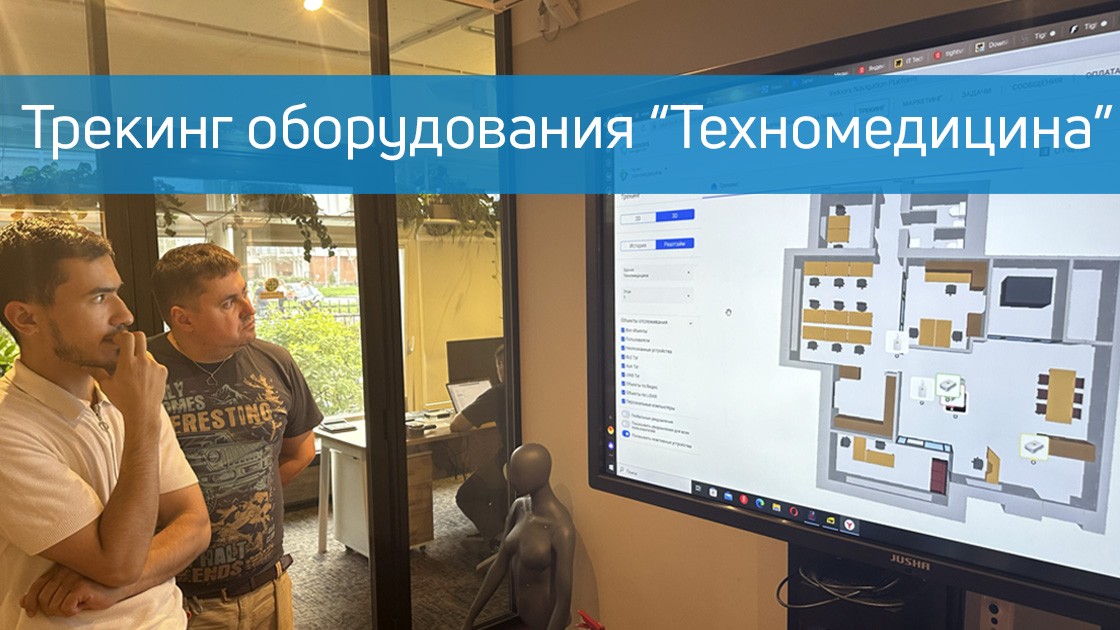
Hospital navigation
The use of modern indoor positioning systems makes it possible to improve the quality of customer service, simplify the work of medical personnel and reduce the operating costs of a medical institution.
Digitalization of medical institutions makes it possible to raise the level of patient care, creating maximum comfort of stay and a positive user experience.
The INP solution successfully helps to manage the internal processes of hospitals and polyclinics, effectively distribute the burden on staff, administer material resources and equipment.
Analytical data suggests that 20% of visitors ask for help from medical professionals with directions, thereby distracting them from their direct duties.

Often in medical institutions, visitors regularly encounter certain difficulties in finding the right office or ward. The presence of several buildings, passageways and confusing corridors significantly complicates orientation and forces patients to spend extra time searching for the right place. Similar difficulties are faced by staff who do not have time to come to the ward on time to provide assistance.
In any clinic and hospital, the problem of finding the right equipment and drugs, monitoring their movement and safety is always urgent. Missing tangible assets increase costs and complicate the work of employees.
The Indoors Navigation Platform (INP) is suitable for solving infrastructure management tasks in any medical institution: polyclinics, hospitals, diagnostic centers, and emergency inpatient facilities.
The geographic information system (GIS) and Indoor navigation for visitors to hospitals and polyclinics are an opportunity to visualize their location and the right room in a medical facility in real–time mode.
It is enough for a visitor to use their mobile phone to search for required doctors' offices, a ward during a hospital visit, test rooms or undergoing procedures. To get to them with minimal waste of time due to the shortest route and navigation, as in the navigator, and as a result, get maximum satisfaction from the visit by increasing the level of loyalty to this medical institution.
Advantages of implementing a geographic information system (GIS) for hospitals and polyclinics:
Improving the quality of patient care:
Using the navigation system in the clinic or hospital, visitors will be able to quickly find the right doctor's office, treatment rooms or test rooms. GIS will create the shortest path to the desired point and save time by building a route based on stairs and elevators for MGN
Tracking of equipment and medications in the hospital:
GIS allows you to optimize hospital asset management through an asset tracking solution. The staff of the medical institution will be able to quickly track the location of the equipment (ultrasound machines, wheelchairs, etc.), minimizing the search time. The loss of expensive drugs will be significantly reduced.
Monitoring of polyclinic staff:
A tracking system is used to increase labor efficiency by optimizing the working hours of medical workers and monitoring their performance of their duties. Employees will spend more time caring for patients and less time smoking or drinking tea, knowing that their management has such information.
Ensuring social distance and restricted areas:
GIS automatically informs about a large gathering of people in one room or entering dangerous (restricted) areas.
Electronic queue and notification:
GIS can monitor an electronic queue linked to a geographic location and send notifications to visitors when it's their turn to enter the office.

Client orientation
The new standard of visitor service and patient care allows you to create maximum comfort when visiting a polyclinic or hospital.
The use of modern indoor positioning systems makes it possible to improve the quality of customer service, simplify the work of medical personnel and reduce the operating costs of a medical institution.
Simplify your navigation by using a multifunctional map and navigator on devices that are already familiar to everyone.
Use our INP platform with a wide range of modern marketing and analytical tools to ensure safe and efficient patient care and simplify the work of staff.
What the patient and the visitor get:
- A map of a polyclinic or hospital with buildings, doctors' offices, and wards.
- Plotting a route and guiding it to any location in real time.
- Receive personalized notifications based on your location.
- A remote appointment with a doctor and an electronic queue.
- Reports on cabinet visits and the history of visits.
- A communication channel with a medical institution, targeted chats and reviews of doctors.
- Barrier-free environment for low mobility groups of the population (MGN).
- An electronic assistant and guide for people with disabilities, including the blind.
- Gamification of the visiting process through the use of augmented reality. AR clinic navigation and virtual game scenarios.

Digitalization
In modern realities, digitalization of processes occurring at all levels of functioning of a medical institution is a key management tool. INP successfully helps to manage the internal processes of medical institutions.
Make it easier for employees to manage a large medical center or hospital consisting of several buildings, allowing them to distribute workload and resources more efficiently.
Send personalized and relevant notifications to patients and staff, ensuring that they are reviewed in a timely manner when they enter a specific area.
What does a medical institution get?:
- An interactive map of a polyclinic or hospital with all its facilities and assets
- Statistical data and analytical reports in different time periods.
- Tracking the movements of medical staff, equipment and drugs in real time on the map, improving the safety of the hospital's material assets.
- The ability to manage workflows online.
- Optimization of patient and visitor flows.
- A new patient feedback channel in one platform.
- Improving the safety of patients and healthcare workers .
Effectiveness and relevance
The introduction of the INP geographic information system, the use of positioning and tracking tools, will be able to increase the efficiency of polyclinics and hospitals by 12%, relieve 5% of the burden on medical workers, improve the quality of patient care by 20%, and asset safety by 35% (equipment and drugs).
Thematic publications on our blog

Real-time location services: Problem solving
The pandemic has significantly increased the burden on healthcare workers due to the high number of critically ill patients, reduced medications, and increased disease risks. Increased workload for many employees…

Interactive navigation in the clinic Be Healthy with face recognition.
The Indoors Navigation team has deployed a system for tracking the movement of personnel and medical equipment in the showroom of the official distributor of professional medical equipment, Techno Medicine Company. Equipment was installed in several rooms — receivers for measuring…
Thematic case studies in our portfolio


Frequently Asked Questions about Indoors Navigation Platform (INP) in Medical Institutions (FAQ)
How does the INP internal positioning system help improve care in medical institutions?
Medical facilities are mostly overcrowded and have large interior spaces. It can be difficult for patients to find a suitable place for admission. With the INP indoor positioning system, users can easily find the right cabinets without any stress.
Can visitors get additional information about the medical facility using the INP system?
Yes, the INP system can provide visitors with additional information about the medical facility, such as appointment schedules, information about doctors, and more.
What information is available to users in the INP app?
In the INP application, users can view a map of the building, find the right room or ward, get directions along the way, and receive information about the schedule of appointments and services.
How can internal positioning help in hospital emergency management?
In emergency situations, the INP internal positioning system can help in tracking assets and personnel. The maps will show the location of all important cars and the location of doctors. This will help you react quickly in life-threatening situations.
Is it possible to use the INP internal positioning system to track medical equipment?
Yes, the INP internal positioning system can be used to track the location of medical equipment. This can help you quickly find the right equipment, if necessary, and improve its safety.
How does the INP internal positioning system work?
The INP geographic information system uses various technologies: Bluetooth, Wi-Fi, AoA BLE, UWB, GPS and Glonass to track the location of patients and staff inside the building. Location information is displayed on the map in a browser, an information chat, and a mobile app that users can use to navigate.
How long does it take to implement interactive INP navigation in a medical facility?
It usually takes about one week to implement interactive navigation. For more information about the integration process, see the documentation section.
Does the technology require any additional hardware installations?
The INP internal positioning system can work in a browser without using additional hardware. If real-time tracking is required, it requires the installation of equipment in accordance with the selected technology: BLE positional sensors, Wi-fi/ Bluetooth gateways, UWB receivers or AoA locators.
What is the accuracy of the INP internal positioning system?
The accuracy of the INP internal positioning system may depend on the type of equipment used and the chosen technology, and may vary from 0.5 meters to 3 meters.
What types of devices does the INP internal positioning system support?
The INP geographic information system supports most modern devices, including smartphones running on iOS and Android, as well as devices running on Windows and Mac OS.
Do I need to download a special application to use the INP system?
Not obligatory. You can use GIS INP in the browser without installing third-party applications, just scan the QR code or download the map from the link.
To use the ability to navigate a route in real time and track movements, you need to download a special application that can be found in the appropriate stores for your device or integrated into your application using IndoorsSDK.
Where is all patient data stored and how can it be used?
The patient data collected using the indoor positioning system can only be used to optimize routes and better resource planning. They are stored in encrypted form on the servers of the medical institution.
How is data security ensured in the INP system?
The INP system uses modern data encryption methods and other security measures to protect patient and staff information. All information is stored on secure servers and is accessible only to authorized users.
Does the INP system monitor my personal data?
The INP system collects data only about the user's location, and this data is used only to ensure more efficient navigation inside the medical facility. All data is stored on secure servers and is not shared with third parties without your consent.
Can patients turn off the INP internal positioning system?
Yes, patients can disable the INP internal positioning system in their privacy settings. However, this may make it difficult to find the right rooms or wards, and they may require additional orientation time.
Is it possible to integrate the INP internal positioning system with other medical systems?
Yes, the INP internal positioning system can be integrated with other medical systems such as patient management systems, electronic medical records, and others.
How is the cost of implementing indor navigation in a hospital or polyclinic determined?
The cost of implementing navigation in the premises of a polyclinic or hospital depends on several factors, including the area, number of floors and layout of the building, the number of rooms and users, the type of technology used and the accuracy of positioning, the required functionality of the system.
It is important to note that the introduction of indor navigation will help reduce time and improve the quality of patient care, as well as increase the efficiency of the staff of the medical institution, which will help to recoup investments in the system within a few years.
